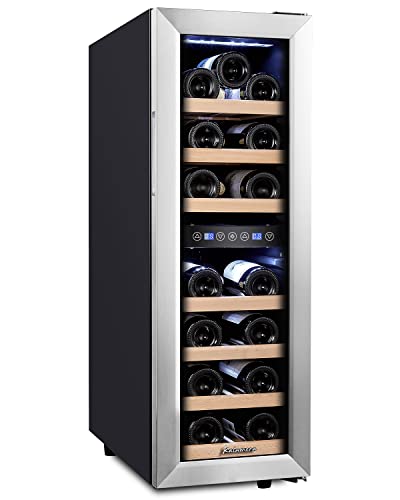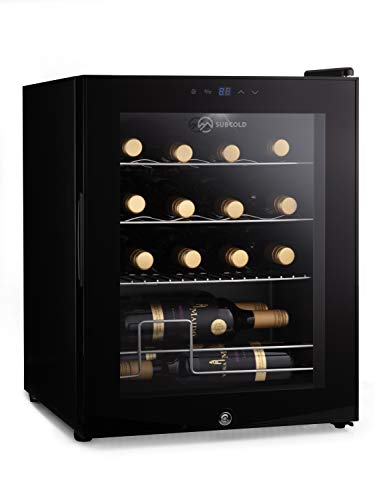This History Behind Wine Refrigerator Built In Can Haunt You Forever!
페이지 정보

본문
 Energy Efficient Wine Storage With a wine fridge kitchen Refrigerator Built in
Energy Efficient Wine Storage With a wine fridge kitchen Refrigerator Built inKeep your wine at the ideal temperatures for serving or storage with this energy efficient built in wine refrigerator. Dual temperature control zones allow you to keep white and red wines separately, preserving their full flavors.
Meticulously crafted to blend seamlessly into your cabinetry, these units can be placed under cabinet wine refrigerator countertops to provide easy access to a refreshing glass of Riesling after dinner. They require adequate ventilation and clearance in order to disperse the heat.
Capacity and Size
A cheap wine fridge refrigerator that is built-in provides a sleek and stylish alternative to the bulky freestanding units. These wine coolers are designed with front vents and can be recessed in cabinets or under counters for a seamless appearance. They also allow for an easier storage solution that allows you to change from cold to wine drinks.
These wine refrigerators can hold up to 368 bottles and are ideal for serious collectors who have many bottles. These units are designed to ensure the safety of your wine for a long time by ensuring that they have ample storage space and precise temperature control. These units are perfect for basements, garages and spaces that are not air-conditioned, and where a rugged and robust storage environment is needed.
The capacity for cooling wine refrigerators is typically measured by the number of standard Bordeaux-style bottles it can accommodate. However, you must be aware of whether your collection of wines includes different sizes of bottles, such as Burgundy or Champagne. This will impact the capacity of your bottle, since these bottles require more space than the Bordeaux standard bottle. Some wine refrigerators come with adjustable shelves that provide flexibility for storing different sizes of bottles.
You'll also need to think about the best location for it. If you're looking to build it into existing cabinetry, it's important to remember that you will need adequate space on the right and left side of the unit, as well as six inches of clearance at the back. This allows the heat produced by the wine refrigerator to escape, and also prevent overheating.
You should think about the possibility of adding one of these top rated wine refrigerators (http://cucq.co.uk)-of-the-line wine fridges in your kitchen if you want to splash out on an expensive model with an exquisite stainless finish. These models will bring a touch of luxury to your home thanks to their sleek and elegant door designs. These units are also available with larger capacities and are ideal for those who enjoy hosting large parties and gatherings. With a range of features, such as dual-zone cooling and UV protection These wine refrigerators are perfect for those looking to take their hosting game up to the next level.
Ventilation
If a wine fridge is not properly ventilated hot air can build up and cause the appliance to overheat. Ventilation is crucial because it allows the cooler to maintain a consistent temperature and humidity level as well as preventing fluctuations in temperature that could damage the wine bottles or alter the flavor of the wine. Check your wine fridge after it has been running for a few minutes to make sure it has the right ventilation system. If the fridge feels cool to the touch, then it has adequate ventilation.
The majority of wine refrigerators have an internal sensor that monitors temperature and alerts you when it's out of the range. Some models have dual temperature-controlled zones to allow you to store different types of wines at ideal serving temperatures.
The ideal temperature to store wine is between 55 and 66 degrees Fahrenheit. This will prevent the development of cork rot and other issues that can damage your collection. Some models come with a lamp that will illuminate when the temperature inside is below the desired level.
Depending on your storage needs, a built in wine refrigerator is the perfect option to accommodate your entire collection. These units can be installed seamlessly under countertops in kitchens or in bar areas for guests with an easy access. Some models feature front vents which means they can be mounted flush with your cabinetry to create a sleek appearance.
To install a wine refrigerator, it is essential to carefully measure the designated space and account for the cabinet's width. The fridge must be at minimum a few inches from the wall on all sides to allow proper ventilation. If a wine refrigerator is pushed up against a wall or a cabinet, it can clog the vents and prevent heat from exiting. Freestanding wine refrigerators feature vents on the sides or rear to efficiently disperse heat.
Installation
A wine refrigerator that is built-in can add a stylish, functional bar to your home. When choosing the perfect spot for your new appliance you should keep a few things in your mind.
Make sure that the cooler you purchase is equipped with adequate ventilation. If a wine fridge is not properly vented, it will heat up and will eventually decrease its lifespan.
Additionally, you should keep your wine fridge clear of direct sunlight and other sources of heat. This will protect your collection from damaging ultraviolet rays from the sun, and it will also allow it to be cooled more efficiently.
Lastly, make sure your wine refrigerator is not too close to a heating appliance, such as a dishwasher. This could cause your wine to be damaged or to have unpredictable temperature fluctuations.
Wine refrigerators are available in two types: built-in and freestanding. Freestanding wine refrigerators provide more flexibility in terms of installation, whereas built-in units are a perfect fit into your kitchen cabinets. Both are available in various capacities and styles, meaning you can find the perfect design for your home.
To ensure that your new wine refrigerator is able to effectively ventilate, take measurements of the space in which you plan on installing it. If possible you can leave some inches of space around the unit to allow for ventilation. Make sure that the door can be fully opened as well. If it isn't be opened, the racks within will be difficult to reach.
Some models also have specific temperature preferences. For example, some wine refrigerators are able to keep red wines at an optimal serving temperature of 55 degrees Fahrenheit, while others may only be suitable for long-term storage. You might want to consider investing in a dual zone mini wine refrigerator fridge in accordance with your needs. This will allow you to keep long-term wines chilled and serve chilled drinks in the other area.
If you're planning on installing a wine drinks fridge refrigerator that is built into it, make sure you've read the manufacturer's instructions carefully to ensure that your new cooler is properly installed. Wait a few hours after putting it in before turning it on to allow the coolant to settle.
Energy Efficiency
In the present era of expensive energy, it's essential to consider the electricity consumption of any appliance. When purchasing an integrated wine fridge be sure to look for models with an Energy Star rating or certification. This means that the wine fridge has been made with advanced cooling technology and insulation to help save energy.
A wine fridge needs to cool the entire interior of the fridge, as well as the bottles that are stored inside. A larger wine fridge with a greater bottle capacity will use more energy than a smaller model. Also, the ambient temperature of the room can affect the power consumption of the fridge as it works harder to keep an interior temperature that is cooler.
To reduce the amount of energy utilized by your wine fridge, ensure that it's always stocked. This may seem counterintuitive but a wine fridge that is filled with cold, sealed bottles won't have to be as laborious to maintain its internal temperature. Keeping your shelves and bottles in the right arrangement can help your wine refrigerator work more efficiently. If you place your bottles horizontally they will chill more quickly than if you arrange them upright.
Another way to help reduce your wine fridge's energy usage is to select a more modern model that has the latest cooling technology. The latest models are typically more efficient than previous wine refrigerators and can save you as much as PS100 annually in energy costs.
Select a wine fridge with an energy-efficient cooling compressor when you shop. This type of refrigerator is more eco-friendly and uses less energy than wine refrigerators with a high-energy compressor system. Also, consider a thermoelectric wine refrigerator. These wine coolers cool the interior with the Peltier-effect, which consumes much less energy than compressor-based units. They are more sensitive to temperatures and require more regular maintenance. Look for a brand with a reputation for producing top-quality, reliable wine refrigerators. They will likely produce the best refrigerator that is energy efficient with a cooling system and a quiet operation.

- 이전글The Reasons You'll Want To Learn More About Lightweight 3 Wheel Stroller 24.09.19
- 다음글What Is Green Sleeper Sofa And How To Utilize What Is Green Sleeper Sofa And How To Use 24.09.19
댓글목록
등록된 댓글이 없습니다.

